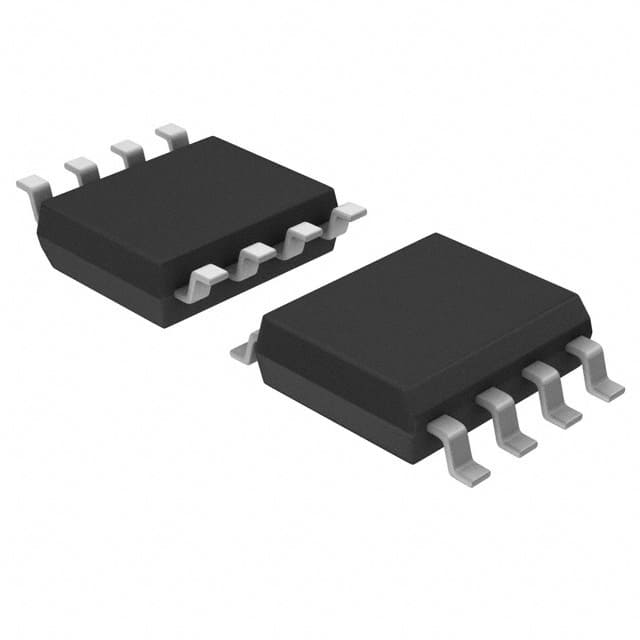Siehe Spezifikationen für Produktdetails.

IXDI604SIATR
Product Overview
Category: Integrated Circuit (IC)
Use: IXDI604SIATR is a high-performance, low-side gate driver IC designed for driving MOSFETs and IGBTs in various applications.
Characteristics: - High-speed switching capability - Low power consumption - Wide operating voltage range - Compact package size - Robust design for reliable operation
Package: The IXDI604SIATR is available in a small outline integrated circuit (SOIC) package, which ensures easy integration into electronic circuits.
Essence: This IC serves as a crucial component in power electronics systems, enabling efficient and precise control of MOSFETs and IGBTs.
Packaging/Quantity: The IXDI604SIATR is typically sold in reels containing 250 units per reel.
Specifications
- Supply Voltage Range: 4.5V to 35V
- Output Current: 4A (peak)
- Propagation Delay: 50ns (typical)
- Operating Temperature Range: -40°C to +125°C
- Input Logic Compatibility: CMOS/TTL
Detailed Pin Configuration
The IXDI604SIATR features an eight-pin configuration:
- VCC: Supply voltage input
- IN: Logic input signal
- LO: Low-side output
- COM: Common ground
- VS: Bootstrap supply voltage
- HO: High-side output
- SD: Shutdown input
- VBS: Bootstrap capacitor voltage
Functional Features
- High-speed switching: The IXDI604SIATR enables fast switching of MOSFETs and IGBTs, reducing power losses and improving overall system efficiency.
- Low power consumption: This IC minimizes energy consumption, making it suitable for battery-powered applications.
- Fault protection: It incorporates various protection features, such as under-voltage lockout (UVLO) and over-temperature shutdown, ensuring safe operation.
- Logic level input compatibility: The IXDI604SIATR is compatible with both CMOS and TTL logic levels, providing flexibility in system design.
Advantages and Disadvantages
Advantages: - High-speed switching capability improves system efficiency. - Low power consumption extends battery life in portable applications. - Robust design ensures reliable operation in harsh environments. - Compatibility with CMOS and TTL logic levels simplifies integration into existing systems.
Disadvantages: - Limited output current may restrict its use in high-power applications. - Requires external bootstrap capacitor for proper operation.
Working Principles
The IXDI604SIATR operates by receiving a logic-level input signal (IN) and generating corresponding high-side (HO) and low-side (LO) output signals. These output signals control the gate voltage of MOSFETs or IGBTs, enabling or disabling their conduction. By precisely controlling the switching of these devices, the IC facilitates efficient power conversion and amplification.
Detailed Application Field Plans
The IXDI604SIATR finds extensive application in various fields, including:
- Motor control systems
- Switch-mode power supplies
- Uninterruptible power supplies (UPS)
- Solar inverters
- Electric vehicle charging stations
- Industrial automation
Detailed and Complete Alternative Models
- IXDI404SIATR: Similar to IXDI604SIATR but with a lower output current rating of 2A.
- IXDI604SIA: Through-hole version of IXDI604SIATR for easy soldering and prototyping.
- IXDI604SI: Surface-mount version without the shutdown input (SD) pin.
These alternative models offer similar functionality and can be considered based on specific application requirements.
Word count: 411 words
Listen Sie 10 häufige Fragen und Antworten im Zusammenhang mit der Anwendung von IXDI604SIATR in technischen Lösungen auf
Sure! Here are 10 common questions and answers related to the application of IXDI604SIATR in technical solutions:
Q: What is IXDI604SIATR?
A: IXDI604SIATR is a course code that stands for "Interaction Design for Interactive Technologies and Responsive Spaces."Q: What is the purpose of studying IXDI604SIATR?
A: The purpose of studying IXDI604SIATR is to gain knowledge and skills in designing interactive technologies and responsive spaces.Q: How can IXDI604SIATR be applied in technical solutions?
A: IXDI604SIATR can be applied in technical solutions by using principles of interaction design to create user-friendly and engaging interfaces for various devices and systems.Q: What are some examples of technical solutions where IXDI604SIATR can be applied?
A: Examples include mobile apps, websites, smart home systems, virtual reality experiences, and interactive installations.Q: How does IXDI604SIATR contribute to the success of technical solutions?
A: IXDI604SIATR contributes to the success of technical solutions by ensuring that they are intuitive, usable, and meet the needs of the users.Q: What are some key concepts covered in IXDI604SIATR?
A: Key concepts covered in IXDI604SIATR include user-centered design, usability testing, prototyping, information architecture, and user experience (UX) design.Q: How can IXDI604SIATR help improve the accessibility of technical solutions?
A: IXDI604SIATR emphasizes inclusive design practices, which can help improve the accessibility of technical solutions for people with disabilities or diverse needs.Q: Are there any ethical considerations addressed in IXDI604SIATR?
A: Yes, IXDI604SIATR covers ethical considerations such as privacy, data security, and the responsible use of technology.Q: Can IXDI604SIATR be applied to both software and hardware solutions?
A: Yes, IXDI604SIATR can be applied to both software and hardware solutions as it focuses on designing interactions between users and technology.Q: What career opportunities are available for those who have studied IXDI604SIATR?
A: Career opportunities include UX/UI designer, interaction designer, information architect, usability analyst, and user researcher in various industries such as tech companies, design agencies, and research institutions.
Please note that the answers provided here are general and may vary depending on the specific context and curriculum of the course.

